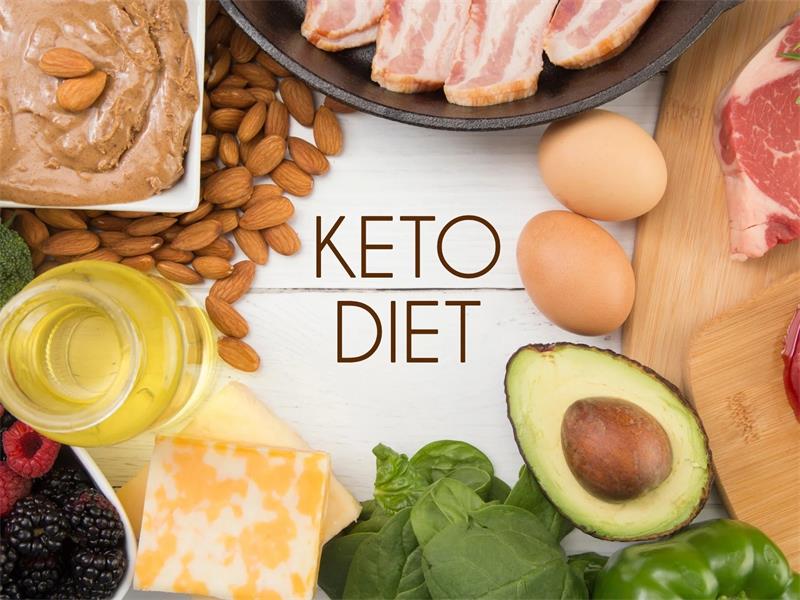Contents
What is Keto Diet and Why is it Popular?
In recent years, the ketogenic or keto diet has gained a great deal of attention for its reported success in helping people lose weight and improve their overall health. The popularity of this diet can be attributed to its effectiveness in causing the body to enter into a metabolic state called ketosis.
This state is achieved by drastically reducing carbohydrate intake while increasing fat consumption. The result is that instead of using glucose (sugar) for energy, the body starts burning fat for fuel.
The keto diet has become increasingly popular among those seeking weight loss, as it has been shown to help individuals lose weight quickly and effectively. However, beyond just weight loss, the keto diet has also been touted as having potential benefits for specific health conditions such as diabetes and neurologic disorders.
What Does the Keto Diet Entail?
The keto diet involves a significant reduction in carbohydrate intake and an increase in healthy fats. Typically, individuals on this diet consume 70-80% of their daily calories from fats, 15-20% from protein, and only 5-10% from carbohydrates.
Carbohydrates are restricted because they are converted into glucose which then triggers an insulin response from the pancreas. Insulin signals your body to store glucose as glycogen or fat cells which leads to weight gain over time.
By restricting carbohydrates we reduce insulin secretion and force our bodies to use ketones as a source of energy instead of sugar. While there are various versions of the keto diet depending on individual needs or preferences, all require careful monitoring of macronutrient intake and strict adherence to dietary guidelines that limit carbohydrate intake to achieve ketosis.
What is the Keto Diet?
The ketogenic diet, or “keto” for short, is a low-carb, high-fat diet that has gained popularity in recent years due to its potential health benefits. The goal of the keto diet is to achieve a state of ketosis, which occurs when your body starts burning fat for fuel instead of carbohydrates. This metabolic state can be achieved by drastically reducing your carbohydrate intake and increasing your fat intake.
Definition and Explanation of Ketosis
Ketosis is a natural metabolic process that occurs when the body doesn’t have enough carbohydrates to burn for energy. Instead, it begins to break down stored fat into molecules called ketone bodies, which are used as an alternative source of fuel in place of glucose.
When you follow a keto diet and restrict your carbohydrate intake to 20-50 grams per day (depending on individual needs), your body will enter a state of nutritional ketosis. This means that it’s producing and using ketones for energy instead of glucose from carbs.
How the Keto Diet Works to Achieve Ketosis
The keto diet works by reducing your carbohydrate intake so drastically that your body must switch from using glucose as its primary source of energy to using fat instead. This transition puts you into a state known as ketosis.
When you eat fewer carbs than usual, your liver will start producing more ketones as an alternative fuel source for the brain and other organs. As you continue to eat fewer carbs and increase dietary fats like butter, coconut oil, avocadoes and olive oil; the muscles use some fatty acids instead of carbohydrates for both their energy production during exercise or work activities while glycogen (stored sugar) gets slowly depleted in order not have high blood sugar levels but still maintain stable blood sugar levels through ketone bodies.
Types of Foods Allowed and Avoided on the Keto Diet
When following a keto diet, there are certain foods that you should prioritize and others that you should avoid or limit. Foods that are high in healthy fats, moderate in protein, and low in carbohydrates are encouraged on the keto diet.
These include:
- Meat, poultry, fish and seafood
- Eggs
- Nuts and seeds
- Dairy products like cheese, butter and cream (preferably from grass-fed cows)
- Vegetables that grow above ground (e.g., leafy greens)
- Berries (e.g., strawberries)
In contrast, foods to avoid or limit on the keto diet include high-carbohydrate items like breads, pasta, rice potatoes; sugary drinks like soda or fruit juice; sweets such as candy bars or ice cream; alcohol which can interfere with ketosis by inhibiting fat-burning.
Benefits of the Keto Diet
Weight Loss Benefits and How it Works
One of the most well-known benefits of the keto diet is weight loss. By consuming a low-carb, high-fat diet, your body enters a state of ketosis and begins to burn fat for energy instead of carbohydrates. This means that your body is constantly burning fat, which leads to weight loss over time.
Additionally, studies have shown that people on the keto diet tend to feel less hungry and more satisfied after meals due to the increased consumption of healthy fats and proteins. This makes it easier to stick with the diet long-term and maintain weight loss results.
Improved Blood Sugar Control for Those with Diabetes
Another benefit of the keto diet is improved blood sugar control for those with diabetes. When you consume carbohydrates, they are broken down into glucose (sugar) which can cause spikes in blood sugar levels.
However, by following a low-carb diet like keto, you significantly reduce your intake of carbohydrates which can help regulate blood sugar levels. Research has shown that individuals with type 2 diabetes who followed a ketogenic diet experienced significant improvements in their blood sugar control compared to those who followed a traditional low-fat diet.
Potential Benefits for Neurological Disorders such as Epilepsy
The benefits of the keto diet extend beyond just weight loss and blood sugar control. In fact, studies have shown that following a ketogenic diet may have potential benefits for neurological disorders such as epilepsy. During ketosis, your body produces molecules called ketones which can provide an alternative source of energy for brain cells when glucose levels are low (such as during fasting or carbohydrate restriction).
This has been found to have therapeutic effects on children with epilepsy who do not respond well to medication. Overall, while more research is needed in this area, these potential benefits make the keto diet worth considering for those with neurological disorders.
Risks of the Keto Diet
Nutrient Deficiencies Due to Restricted Food Choices
One of the biggest risks associated with the keto diet is the potential for nutrient deficiencies. This is due to the limited food choices allowed on this eating plan.
Since carbohydrate-rich foods are restricted, individuals following a keto diet may not be getting enough of certain vitamins and minerals that are typically found in foods like fruits, vegetables, and whole grains. For example, fruits and vegetables contain important nutrients like vitamin C, potassium, and fiber.
Whole grains are rich in B vitamins and fiber as well. Without these foods in their diet, those following a keto diet may risk deficiencies in these important nutrients.
To mitigate this risk, it’s essential for those following a keto diet to incorporate nutrient-dense foods into their meal plans. This can include low-carb vegetables like spinach and broccoli, nuts and seeds like almonds and chia seeds for healthy fats and protein content.
Increased Risk for Heart Disease Due to High Intake of Saturated Fats
Another potential risk associated with the keto diet is an increased risk of heart disease due to a high intake of saturated fats. While it’s true that consuming healthy fats such as monounsaturated fatty acids (MUFAs) can be beneficial for overall health, too much-saturated fat intake can lead to elevated cholesterol levels which may increase one’s risk of cardiovascular disease. Many popular keto-friendly foods such as bacon, butter, and cheese contain relatively high amounts of saturated fat which could easily exceed recommended limits if taken excessively.
It’s therefore important that individuals who follow this dietary pattern choose lean protein sources like fish or chicken over red meats or pork belly. They should also consider increasing healthy unsaturated fat consumption through sources such as avocados or olive oil rather than relying solely on animal-based products.
Potential Negative Effects on Athletic Performance
The keto diet may also pose a risk for those who engage in intense physical activity or sports. This is because carbohydrates are the primary fuel source for high-intensity activities, and individuals who are following a keto diet severely restrict their carbohydrate intake.
This limited carb intake can lead to decreased exercise performance, as the body may not have enough glycogen stores (the stored form of carbohydrates) to fuel the demands of intense physical activity. Additionally, since protein is also restricted on the keto diet, adequate protein consumption is essential to preserve muscle mass and prevent catabolism due to insufficient energy intake.
While there are potential benefits to following a keto diet, it’s essential to understand and mitigate its risks. Individuals should consult with their healthcare professional before starting this dietary pattern, consider supplementing nutrient-dense foods into their meals and monitor their protein and fat intake carefully for optimal health outcomes.
Tips for Safely Following a Keto Diet
While the keto diet can be effective for weight loss and blood sugar control, it’s important to approach it safely and with guidance from a healthcare professional. Here are some tips to help you safely follow a keto lifestyle:
Importance of Consulting with a Healthcare Professional Before Starting
Before starting the keto diet, it’s important to consult with your doctor or a registered dietitian. They can help determine if the keto diet is right for you based on your health history and current medications.
Additionally, they can provide guidance on how to safely transition into ketosis without putting your health at risk. Your healthcare professional may also recommend monitoring certain nutrient levels, such as electrolytes and vitamins, while following the keto diet.
This is because the restricted food choices on the keto diet can lead to deficiencies if not monitored closely. Make sure to keep track of what you’re eating and discuss any concerns with your healthcare provider.
Recommendations for Monitoring Nutrient Intake
One way to ensure that you’re getting all of the nutrients your body needs while following the keto diet is by tracking your intake using an app or website that provides nutritional information. This will allow you to see if you’re meeting your daily nutrient goals and adjust accordingly.
In particular, make sure that you’re getting enough healthy fats, protein, fiber-rich vegetables, and low-carb fruits in order to maintain good health while in ketosis. Additionally, supplementing with electrolytes such as sodium and potassium can help prevent feelings of fatigue or lightheadedness that can sometimes occur when starting out on the keto diet.
Suggestions for Incorporating Physical Activity into a Keto Lifestyle
Incorporating physical activity into your keto lifestyle can help optimize your weight loss and overall health. Aim for at least 30 minutes of moderate-intensity exercise most days of the week, such as brisk walking, cycling, or swimming.
Additionally, resistance training can help build muscle and prevent muscle loss while following a calorie-restricted diet like the keto diet. Consider working with a personal trainer or attending a group fitness class to learn the proper form and technique for weightlifting exercises.
Remember that it’s important to listen to your body and adjust accordingly when it comes to physical activity while on the keto diet. Don’t push yourself too hard if you’re feeling lightheaded or fatigued, and make sure to stay hydrated by drinking plenty of water before, during, and after exercise.
Conclusion
After reviewing the potential benefits and risks of the keto diet, it is clear that this diet is not for everyone. While some may find success in achieving weight loss and improved blood sugar control, others may experience negative side effects such as nutrient deficiencies and an increased risk for heart disease. It is important to consult with a healthcare professional before starting the keto diet, as they can provide guidance on how to safely and effectively follow this eating plan.
Additionally, monitoring nutrient intake and incorporating physical activity can help mitigate some of the potential negative effects. While the keto diet may be trendy, it is not a magic solution for everyone.
It requires a lot of effort and discipline to maintain this type of eating plan long-term. Before embarking on any major dietary changes, it’s important to consider your individual health goals and needs in consultation with a professional.
Overall, whether you choose to follow the keto diet or not, remember that there are many ways to achieve good health through proper nutrition and regular physical activity. Don’t forget to listen to your body’s needs and make choices that support your overall well-being.













